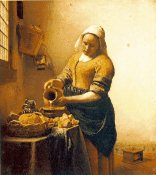The Milkmaid
Amsterdam, Rijksmuseum
46x41 1658-60
 (Large)
(Large)
The milkmaid is a servant, but is painted with grace and dignity,
not lechery or suggestions of laziness, as was the custom in depicting
servants. This painting has always been one of Vermeer's most popular,
selling for 175 guilders in the Amsterdam auction of 1696,
second only to The View of Delft.
The painting exemplifies the sturdy maid, humbly going about her
everyday duties, elevating her to a paragon of homely virtue. She might
be seen as the essence of the Dutch character:
strong, simple, and direct. The painting style is certainly
bold and vigorous, the colors strong and earthy.
Her concentration is directed completely at the milk flow, and the stream
of white paint is uncannily realistic. The light from the window adds
to the input to this flow, and below the table the blue cloth continues
the suggestion of flow. Also concealed in this composition is a set of
arcs: the woman's face, bonnet, shoulders, bosom, and her apron; the
jug from which she pours and the bowl she pours into; a basket, loaves,
and a pitcher on the table present more arcs; the basket and brass box on
the wall have arcs in their shape.
The jug, bowl, pitcher and bread have brilliant impasto sparkles, and
the contour of the woman's back and dress is emphasized with a thin white line.
This device separates her from the background, and emphasizes the
rich azure and yellow of her clothing.
X-rays reveal that a map on the back wall has been painted over. It would
seem quite inappropriate for a kitchen to have such an expensive item.
There is a foot-warmer on the floor, and the Delft tile at the bottom
of the wall shows travelling artisans who carry their tools with them.
Brought to you by
Roy Williams Clickery.
 (Large)
(Large)